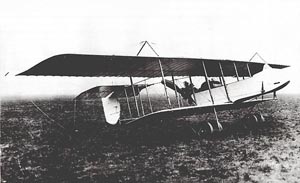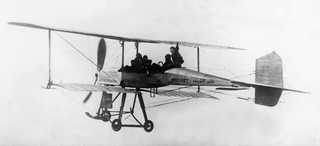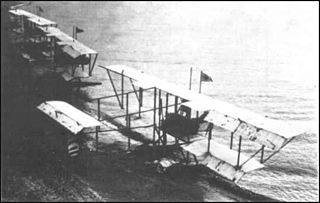Related Research Articles

The Farman F.220 and its derivatives were thick-sectioned, high-winged, four engined French monoplanes from Farman Aviation Works. Based on the push-pull configuration proven by the F.211, design started in August 1925 and the first flight of the prototype was on 26 May 1932. The largest bomber to serve in France between the two world wars was the final F.222 variant. One variation was intended to be an airliner.

The Voisin Canard was an aircraft developed by Voisin brothers during 1910 and first flown early in 1911. It was named the Canard because of the resemblance of its forward fuselage to that of a duck's long neck while in flight. It was originally flown as a landplane: with the addition of floats it became one of the first seaplanes used by the French Navy.

The Antoinette military monoplane, also known as the Antoinette Monobloc or the Antoinette-Latham was an early 3-seat monoplane built in France in 1911 by the Antoinette company in the hope of attracting orders from the French military. It featured a futuristic and aerodynamic design with innovative elements that were ahead of its time, including unbraced cantilever wings, an enclosed fuselage and wheel fairings, and an engine with steam cooling and direct fuel injection. However, due to an under-powered engine, it was barely able to fly and failed to attract orders.

The Maurice Farman MF.7 Longhorn is a French biplane developed before World War I which was used for reconnaissance by both the French and British air services in the early stages of the war before being relegated to service as a trainer.

The Astra C was a 1912 French single engine biplane, manufactured by Société Astra at Villacoublay. In 1913, the Astra CM Hydro-avion three-seat floatplane version was used to make the world's first scheduled passenger-carrying flights.

The Farman F.160 was a heavy bomber aircraft developed in France in the late 1920s. It was essentially an attempt by Farman Aviation Works to modernise its tremendously successful F.60 Goliath design of the immediately postwar years. The most noticeable external difference was the larger tailfin of the new aircraft. Like its predecessor, it was a large three-bay biplane of conventional configuration with unstaggered wings of equal span. Initially conceived as a heavy night bomber, most examples built were float-equipped torpedo bombers for the Aéronautique Maritime, which operated some 40 of the F.165 variant and 200 of the F.168. One of the original F.160 night bombers was exported to Italy, and one to Japan. Plans to develop airliner versions did not progress past the prototype stage.

The Farman HF.20 and its derivatives were a family of reconnaissance aircraft produced in France shortly before and during the First World War. It was a refined version of the Farman MF.11 "Shorthorn" that did away with the type's distinctive landing skids, and incorporated design features from Henri Farman's designs. It entered service with the French, Belgian and Serbian armies in 1913, and with the British RFC and RNAS shortly after the outbreak of war. The type was also licence-built in the UK by Airco and Grahame-White.

The Lioré et Olivier LeO 20 was a French night-bomber aircraft built by Lioré et Olivier.

The Nieuport IV was a French-built sporting, training and reconnaissance monoplane of the early 1910s.

The Breguet Type IV was an aircraft built by Breguet Aviation. It was first flown in 1911, and was the first Breguet aircraft to be produced in quantity. It was used by the French Army and the British Royal Flying Corps. It is notable for the extensive use of metal in its construction, unusual in an aircraft of its time.
The Caudron Type C was a single seat French biplane, intended for military evaluation. Two were built in 1911.

The Farman HF.14 was a French two seat reconnaissance type produced by Farman Aviation Works before World War I.
The Goupy Hydroaeroplane was a floatplane developed by Ambroise Goupy in 1912, which was displayed at the 1912 Paris Aero Salon. It was described in Flight as being generally comparable to a Goupy biplane designed by Alphonse Tellier displayed the year before, except for the change from wheels to a pair of pontoon-style floats. Janes 1913 stated that at least one had been built in 1912, and that the company was producing around 30 a year, but actual production numbers are not known beyond the 1912 demonstrator. An editorial review of the 1913 Paris Aero Salon bemoaned the lack of advancement in Goupy designs, with no display of a seaplane.

The Farman HF.6 was a reconnaissance aircraft built in France shortly before the First World War.

The Farman HF.7 was a reconnaissance aircraft built in France shortly before the First World War.
The Maurice Farman MF.16 was a French reconnaissance aircraft developed before World War I by the Farman Aviation Works.
The Farman HF.16 was a reconnaissance aircraft built in France shortly before the First World War. Aircraft of this type were also produced under license in the Russian Empire and served with the Imperial Russian Air Service during World War One.
The Henry Farman HF.19 was a French reconnaissance seaplane developed by Henry Farman before World War I. As a floatplane, it used floats for take-off and landing on water.
The Reims Military Aviation Competition was a military aviation competition held in Reims in October 1911 that was organized by the French Army, with the purpose of trialling the performance of new aircraft for potential use by the French military. Although a number of aeronautical records were beaten during the competition, there were also a number of crashes and fatalities. It began on Friday October 6, 1911.

The Morane-Borel military monoplane was an unsuccessful French single-engine, multi-seat prototype aircraft built in 1911 for the Reims Military Aviation Competition hosted by the French Army. The aircraft only met one of the requirements and was eliminated from the competition.
References
- ↑ "Farman HF.10".
- ↑ Hartmann, Gérard. Les premiers Farman [The First Farmans](PDF) (in French). Retrieved 2024-09-20.